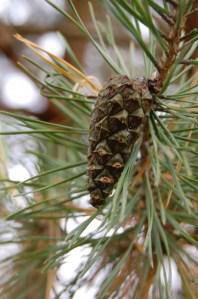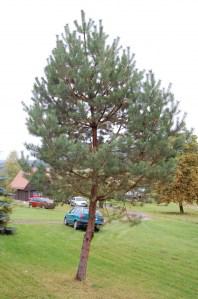
Pinus sylvestris cone (08/10/2011, Horní Bečva, Czech)
Position: Full sun
Flowering period: Summer
Soil: Well Drained
Eventual Height: 25m
Eventual Spread: 10m
Hardiness: USDA Zones 3a-8b
Family: Pinaceae
Pinus sylvestris is a large,long lived, conical, native, evergreen coniferous tree which eventually spreading into a broad dome . It has a distinctive habit when mature due to its long, bare, straight trunk and branches, which branch horizontally. It’s needle like leaves are stiff and serrated, have a 360 degree twist and are green to blue hue. They are 2.5 – 5 cm long and 1 -2 mm broad. They are produced in fascicles of two with a persistent grey 5-10 mm basal sheath. On younger trees the leaves can be twice as long, occurring in fascicles of 3 and 4 on the tips of strong shoots. The mature trunk of this tree may achieve a diameter of around 1 metre. The bark is thick and scaly, with a dark grey brown colour on the lower trunk, with thin flaky and orange bark on the upper trunk. The trees shoots are light brown with a spirally arranged scale pattern. The seed cones of the tree are red at pollination, eventually becoming pale brown, globose and 4-8mm in diameter in their first year, they then become yellow at maturity and are 3 – 7.5 cm in length. The seeds are blackish, 3 – 5mm long with a pale brown 12 -20 mm wing, they are released when the cone (i.e. the fruit) is opened. The roots can form deep tap roots or a shallor rooting pate.
Pinus sylvestris, commonly known as Scots Pine, Riga Pine and Norway Pine, is native to Europe and Asia,including the UK. It is the most widely distributed conifer in the world. It occurs in the north of its range up to a sea level of 1000 metres, while in the south range it is a high altitude mountain tree growing up to 1200 – 2600 metres. P. sylvestris is the only pine native to northern Europe, forming either pure forests alongside Common Juniper, Silver Birch and Norway Spruce. In Great Britian it occurs naturally in Scotland, but archeological records indicate that it had also occurred in Wales and England until about 300 – 400 years ago, eventually becoming extinct due to over exploitation and grazing. It is the national tree of Scotland, and it formed much of the Caledonian Forest which once covered a lot of the Scottish Highlands, it also formed large parts of forest throughout Britian until 8000 years ago. The trees needles are sharp pointed with some trees being weak growers, developing a yellow needle colour. The native conifer is grown commercially for timber.
The etymological root of the binomial name Pinus is derived from the Latin name for Pine tree. Sylvestris is derived from the Latin silva meaning ‘wood or forest’ referring to this trees preferred growing location.

Pinus sylvestris (08/10/2011, Horní Bečva, Czech)
The landscape architect may find P. sylvestris useful a native specimen tree. It is also use as part of a native woodland mix scheme. It is able to withstand maritime climates and is suitable for planting in coastal locations, it can also tolerate atmospheric pollution.
Ecologically Pinus sylvestris is excellent for wildlife. Lichens and insects grow around in the cracks on the trunk. Ants also are attracted to this tree. Birds such as the Siskin, Spotted Woodpecker and Crossbill can feed well around a Scots Pine. The level branches make good nesting places for birds of prey such as the Golden Eagle, Osprey and Goshawk. Red Squirrels are particularly fond of the seeds and cones of the Scots Pine.
P. sylvestris tolerates most well drained soil but prefers an acidic pH. It will tolerate infertile, dry soils.
Maintenance: P. sylvestris requires little maintenance.

